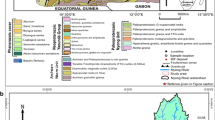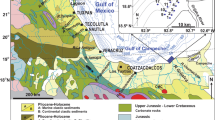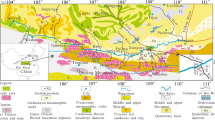Abstract
As a result of recycling, the mineralogical and chemical compositions of riverine sediments may reflect the combined effects of the present-day weathering regime as well as previous weathering and diagenetic alteration history. River sediments can be interpreted as a mixture of non-weathered bedrock—of igneous, metamorphic, or sedimentary origin—and solids formed by the modern weathering system. The correlation between the weathering proxies chemical index of alteration and weathering index of Parker offers an approach to distinguish fine suspended particles, coarse bedload sediments, and recycled sediments under the influence of quartz dilution. Recycling of cation-depleted source rocks formed during past geological weathering episodes may have great impacts on the weathering indices of sediments from the Changjiang (Yangzte) and Zhuoshui Rivers. Special caution is required when using chemical weathering indices to investigate the intensity of chemical weathering registered in fluvial sediments. To minimize the effect of hydrodynamic sorting or sediment recycling, we suggest that the fine sediments (e.g. suspended particles and <2 μm fractions of bedload sediments) in rivers better reflect the average of weathered crust in catchments and the terrigenous end-member in marginal seas.

Similar content being viewed by others
References
Bi L, Yang S, Li C, Guo Y, Wang Q, Liu JT, Yin P (2015) Geochemistry of river-borne clays entering the East China Sea indicates two contrasting types of weathering and sediment transport processes. Geochem Geophys Geosyst 16(9):3034–3052. doi:10.1002/2015GC005867
Cox R, Lowe DR, Cullers RL (1995) The influence of sediment recycling and basement composition on evolution of mudrock chemistry in the southwestern United States. Geochim Cosmochim Acta 59(14):2919–2940. doi:10.1016/0016-7037(95)00185-9
Dadson SJ, Hovius N, Chen H, Dade WB, Hsieh ML, Willett SD, Hu JC, Horng J, Chen MC, Stark CP (2003) Links between erosion, runoff variability and seismicity in the Taiwan orogen. Nature 426(6967):648–651. doi:10.1038/nature02150
Gaillardet J, Dupré B, Allègre C (1999) Geochemistry of large river suspended sediments: silicate weathering or recycling tracer? Geochim Cosmochim Acta 63(23–24):4037–4051. doi:10.1016/S0016-7037(99)00307-5
Garzanti E, Resentini A (2015) Provenance control on chemical indices of weathering (Taiwan river sands). Sed Geol 336:81–95. doi:10.1016/j.sedgeo.2015.06.013
Garzanti E, Padoan M, Setti M, Najman Y, Peruta L, Villa IM (2013) Weathering geochemistry and Sr–Nd fingerprints of equatorial upper Nile and Congo muds. Geochem Geophys Geosyst 14(2):292–316. doi:10.1002/ggge.20060
He M, Zheng H, Clift PD, Tada R, Wu W, Luo C (2015) Geochemistry of fine-grained sediments in the Yangtze River and the implications for provenance and chemical weathering in East Asia. Prog Earth Planet Sci 2(1):1–20. doi:10.1186/s40645-015-0061-6
Nesbitt H, Young G (1982) Early Proterozoic climates and plate motions inferred from major element chemistry of lutites. Nature 299(5885):715–717. doi:10.1038/299715a0
Parker A (1970) An index of weathering for silicate rocks. Geol Mag 107(6):501–504. doi:10.1017/s0016756800058581
Selvaraj K, Chen CTA (2006) Moderate chemical weathering of subtropical Taiwan: constraints from solid-phase geochemistry of sediments and sedimentary rocks. J Geol 14(1):101–116. doi:10.1086/498102
Veizer J, Jansen SL (1985) Basement and sedimentary recycling-2: time dimension to global tectonics. J Geol 93(6):625–643. doi:10.1086/628992
Yang S, Bi L, Li C, Wang Z, Dou Y (2015) Major sinks of the Changjiang (Yangtze River)-derived sediments in the East China Sea during the Late Quaternary. Geol Soc Lond Spec Publ 429(1):137–152. doi:10.1144/SP429.6
Zhou X, Li A, Jiang F, Lu J (2015) Effects of grain size distribution on mineralogical and chemical compositions: a case study from size-fractional sediments of the Huanghe (Yellow River) and Changjiang (Yangtze River). Geol J 50(4):414–433. doi:10.1002/gj.2546
Acknowledgements
This work was supported by National Natural Science Foundation of China (Nos. 41376049 and 41225020), National Programme on Global Change and Air-Sea Interaction (GASI-GEOGE-03), and by AoShan Talents Program Supported by Qingdao National Laboratory for Marine Science and Technology (No. 2015ASTP-OS11).
Author information
Authors and Affiliations
Corresponding author
Additional information
11th International Symposium on Geochemistry of the Earth’s Surface.
Rights and permissions
About this article
Cite this article
Guo, Y., Yang, S., Li, C. et al. Sediment recycling and indication of weathering proxies. Acta Geochim 36, 498–501 (2017). https://doi.org/10.1007/s11631-017-0218-7
Received:
Revised:
Accepted:
Published:
Issue Date:
DOI: https://doi.org/10.1007/s11631-017-0218-7




